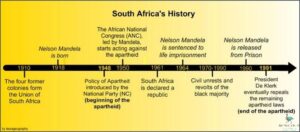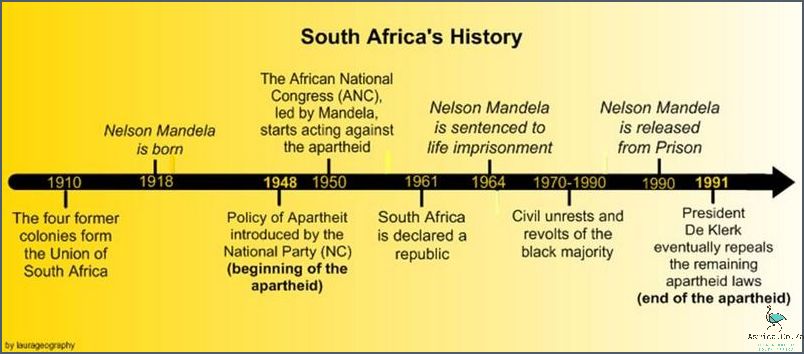
The timeline of Nelson Mandela is a retrospective of the events that shaped the life and legacy of the former South African President and civil rights leader. Nelson Mandela was born on July 18, 1918 in the small village of Mvezo, in what is now Eastern Cape Province. He went on to be an influential anti-apartheid leader, Nobel Peace Prize recipient, and South Africa’s first democratically elected president. Mandela served as president from 1994 to 1999, and his life and work have had a lasting impact on South Africa and the world. This timeline looks at the major events and accomplishments that have shaped Nelson Mandela’s life and legacy.
Contents
Timeline Of Mandela
Nelson Mandela was a South African political leader and a Nobel Peace Prize winner who fought for the rights of the oppressed people in South Africa. He was born on 18th July, 1918 in the Eastern Cape of South Africa. Mandela was a lawyer and a freedom fighter who fought against the Apartheid system in South Africa. In 1964, he was sentenced to life imprisonment for his involvement in the anti-apartheid movement. He was released in 1990 after spending nearly 27 years in prison. He was elected as the first black president of South Africa in 1994 and served until 1999. During his presidency, Mandela was able to bring peace and reconciliation in South Africa. In 1993, he was awarded with the Nobel Peace Prize. Mandela passed away on 5th December, 2013.
Early Life – Where Mandela was born, his early education, and the start of his political career
Nelson Mandela is one of the most iconic figures of the 20th century, having made an indelible impact on the world through his work as an anti-apartheid activist and South African president. His legacy of advocacy for social justice and human rights is well-known, but the story of his early life and beginnings of his political career are less familiar. In this blog post, we’ll be exploring Mandela’s early life, where he was born, his early education, and the start of his political career.
Nelson Mandela was born on July 18, 1918 in the small village of Mvezo, in the Eastern Cape of South Africa. His father, Gadla Henry Mphakanyiswa, was a local chief of the Thembu people, and his mother, Nosekeni Fanny, was the third of his father’s four wives. Mandela was given the name Rolihlahla, which translates to “troublemaker” in the language of Xhosa, but was affectionately referred to as “Nelson” by his teacher when he began attending school at the age of seven.
Mandela’s early education was conducted at a local Wesleyan mission school, where he received instruction in the English language and was exposed to the teachings of Christianity. After completing his primary education, he went on to study at the Clarkebury Boarding Institute and later at the Healdtown Comprehensive School, where he was the first in his family to receive a formal education.
It was during his years at Healdtown that Mandela began to develop a keen interest in politics. He joined the African National Congress (ANC) Youth League in 1944, and in 1952 he was elected president of the organisation. Mandela’s political career was marked by a commitment to non-violent protest and civil disobedience, and he soon became the leader of a campaign to resist the oppressive system of apartheid. This campaign included a boycott of South African products and the organisation of mass protests and strikes.
In 1956, Mandela was arrested and charged with treason for his role in the anti-apartheid movement. He was acquitted in 1961, but his arrest marked a turning point in his political career, as he was forced to go underground in order to continue his work. Mandela was eventually arrested again in 1962 and sentenced to life in prison. He spent the next 27 years behind bars, but his commitment to justice and equality never wavered.
In 1990, Mandela was released from prison and he went on to become the first black president of South Africa in 1994. He continued to advocate for the rights of the oppressed and worked to ensure that all South Africans enjoyed the same rights and freedoms. His legacy of courage and commitment lives on today, and his name is forever associated with the struggle for justice and equality.
Imprisonment – Mandela’s arrest, imprisonment, and release

Nelson Mandela’s arrest and imprisonment are two of the most defining events of the 20th century. His arrest in 1962, and subsequent 27 years of incarceration, was a defining moment in the struggle against apartheid in South Africa. Mandela’s arrest, imprisonment, and eventual release in 1990, marked the beginning of a new era in South African history, and his legacy as a leader of the anti-apartheid movement continues to inspire people around the world.
Mandela was arrested in 1962, after a police raid on his home in the Johannesburg suburb of Rivonia. He was charged with sabotage and other crimes related to the anti-apartheid movement, and was sentenced to life in prison in 1964. During his imprisonment, Mandela became a symbol of the anti-apartheid movement, and his name became synonymous with the struggle against racial injustice.
Mandela’s release from prison in 1990 was met with worldwide celebration, and he quickly became a leader of the newly formed African National Congress (ANC). In 1994, he was elected President of South Africa in the country’s first multi-racial elections, and he served as president until 1999. During his presidency, Mandela worked tirelessly to promote racial reconciliation and to address the economic and social inequalities that had been a legacy of apartheid.
Today, Mandela remains an important figure in the struggle for human rights, and his legacy of peaceful resistance to injustice has been recognized and celebrated around the world. His arrest, imprisonment, and eventual release from prison are a reminder of the power of peaceful resistance to oppression, and his legacy of courage and dedication to justice continues to inspire people around the world.
Presidency – Mandela’s election, domestic and foreign policies, and accomplishments
Nelson Mandela’s election to the presidency of South Africa in 1994 marked a momentous shift in the nation’s history. Mandela’s election was the result of years of struggle against the country’s oppressive Apartheid system, which had segregated the nation’s population along racial lines. During his presidency, Mandela implemented a number of domestic and foreign policies that sought to promote racial reconciliation and economic development. Here, we take a look at some of the key accomplishments of Mandela’s presidency and the impact they had on South Africa and the world.
Domestically, Mandela’s government worked to promote racial reconciliation and to improve the living conditions of all South African citizens. This included the introduction of the Truth and Reconciliation Commission to investigate human rights abuses that had occurred during Apartheid. The commission was widely praised for its ability to bring about racial healing and to ease tensions between different racial groups. In addition, Mandela’s government increased spending on education and health care, resulting in improved access to these services for all citizens.
On the foreign policy front, Mandela was determined to promote reconciliation and peace in the region. He opened diplomatic relations with many African nations, which helped foster a spirit of cooperation between countries. In addition, Mandela and his government worked to resolve conflicts in countries such as Angola, Lesotho, and Mozambique. This resulted in peace agreements that helped to bring stability to the region.
In addition to his domestic and foreign policy accomplishments, Mandela also worked to promote democracy and human rights on the world stage. He was an outspoken advocate for the rights of the oppressed and was a vocal opponent of oppressive regimes such as those in Zimbabwe and Libya. He also worked to promote democracy in countries such as South Africa and Namibia. Finally, Mandela was instrumental in helping to bring about the end of nuclear proliferation and worked to promote global peace and security.
In conclusion, Nelson Mandela’s election to the presidency of South Africa in 1994 was a major milestone in the country’s history. During his presidency, Mandela implemented a number of domestic and foreign policies that sought to promote racial reconciliation and economic development. He was also an outspoken advocate for the rights of the oppressed and worked to promote democracy and human rights on the world stage. These accomplishments helped to shape South Africa and the world for the better.
Conclusion
The timeline of Nelson Mandela’s life is an inspiring story of courage and resilience. He overcame numerous obstacles to become one of the most influential leaders of all time. His life and achievements have been an example to millions around the world. From his humble beginnings to his eventual release from prison, Mandela’s journey has been a source of inspiration and hope. His commitment to justice and human rights will continue to be remembered and celebrated for generations to come.



